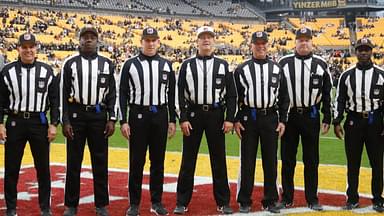The NFL is one of the most loved, watched, and cherished sports leagues in the United States and is gradually spreading its roots around the world. Though the excitement is top-notch, understanding the nuances of the game can be tricky. One such topic a majority of fans seem to ponder is the use of hand signals by the officials. NFL referees use a variety of hand signals to communicate calls and decisions during games, each with its own specific meaning.
Advertisement
In total, there are 34 hand signals, each representing a different call or ruling on the field. Whether you’re a seasoned fan or a newbie, understanding these signals can enhance your viewing experience.
Decoding the NFL Referee Hand Signals
Time In: This signal indicates that the clock should resume running after a stoppage.
Time Out: Used by officials to halt the game clock temporarily — typically called by coaches.
Time Count: Referees use this signal to indicate a delay of the game by the offense, usually due to taking too long to snap the ball.
First Down: A critical signal indicating that the offensive team has advanced enough yardage to gain a new set of downs.
Second Down: This gesture signifies the second play of the offensive series, following a first down or another second down.
Third Down: Indicates the third play of the offensive series, often a crucial moment for the offense to convert and extend their possession.
Fourth Down: A pivotal moment where the offensive team must decide whether to punt, attempt a field goal, or go for it on fourth down.
Touchdown or Field Goal: Celebratory gestures marking a successful scoring play. There are variations depending on whether it’s a touchdown or a field goal.
Safety Touch: A rare signal indicates that the defensive team has tackled an offensive player in their own end zone, resulting in two points for the defense.
Single Point (1 or 2 Pt. Convert): Used to denote an extra point or two-point conversion attempt after a touchdown.
OFFICIAL HAND GESTURES – NFL pic.twitter.com/kBiIpzJL8I
— AnushreeGuptaOfficial (@Anushree_Gupta_) February 11, 2024
Unnecessary Roughness: Indicates various forms of illegal contact or aggression on the field, leading to penalties.
Rough Play & Disqualification: Signifies particularly egregious behavior warranting player ejection from the game.
Face Mask: Identifies illegal grabbing or pulling of an opponent’s face mask, a dangerous infraction that can lead to injury.
Restraining Zone Kick: Used during kickoffs to indicate whether players have stayed within the appropriate restraining zone until the ball is kicked.
Pass Interference: Indicates when a defensive player illegally impedes a receiver’s ability to catch a pass, resulting in a penalty.
Illegal Use of Hands: Denotes infractions involving illegal contact or use of the hands against an opponent.
Blocking from Rear: Signals illegal blocking from behind, a dangerous play that risks injury to the blocked player.
OFFICIAL HAND GESTURES – NFL pic.twitter.com/40vDTJMBfM
— AnushreeGuptaOfficial (@Anushree_Gupta_) February 11, 2024
Piling On: Indicates multiple players from the same team continuing to tackle or pile onto an already downed opponent.
Contacting Kicker: Signals illegal contact with the kicker during a kicking play, often resulting in a penalty.
Offside: Indicates that a player has crossed the line of scrimmage before the ball is snapped, resulting in a penalty.
Procedure: Denotes procedural infractions, such as false starts or illegal formations, by the offense.
Offside Pass: Indicates an illegal forward pass thrown from beyond the line of scrimmage, resulting in a penalty.
Incomplete Pass: Indicates that a pass thrown by the quarterback did not result in a completion, stopping the clock.
Objectionable Conduct: Signals unsportsmanlike behavior or verbal abuse by a player, coach, or sideline personnel.
Illegal Substitution: Denotes violations related to player substitutions, such as having too many players on the field.
OFFICIAL HAND GESTURES – NFL pic.twitter.com/LIhJLDBJhZ
— AnushreeGuptaOfficial (@Anushree_Gupta_) February 11, 2024
Illegal Forward Pass, Ineligible Receiver: Indicates infractions related to forward passing, including illegal forward passes and ineligible receivers downfield.
Penalty Declined: Signals that the team benefiting from a penalty has chosen not to accept it, allowing the result of the play to stand.
Request for Measure: Indicates a request for a measurement to determine if a team has enough yardage for a first down.
Spearing: Identifies a particularly dangerous form of tackling where a player leads with their helmet, resulting in a penalty.
Ineligible Receiver Downfield: Indicates an ineligible player, typically an offensive lineman, illegally downfield during a passing play.
No Mouthguard: Signals a warning to a player who is not wearing a required mouthguard for safety reasons.
Improper Equipment: Denotes violations related to players’ equipment, such as improper helmets or pads.
Blocking Below Waist: Indicates illegal blocking techniques involving contact below the waist, posing a risk of injury.
Intentional Grounding: Identifies when a quarterback throws the ball intentionally to the ground to avoid a sack, resulting in a penalty for intentional grounding.
OFFICIAL HAND GESTURES – NFL pic.twitter.com/QAoCUVevZv
— AnushreeGuptaOfficial (@Anushree_Gupta_) February 11, 2024
As the excitement builds up for the upcoming Super Bowl LVIII, understanding NFL referee hand gestures can come in handy. Whether it’s celebrating a touchdown or being disappointed by a penalty, these gestures will help to build excitement during the grand showdown in Sin City.






